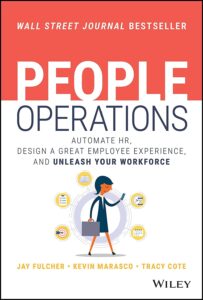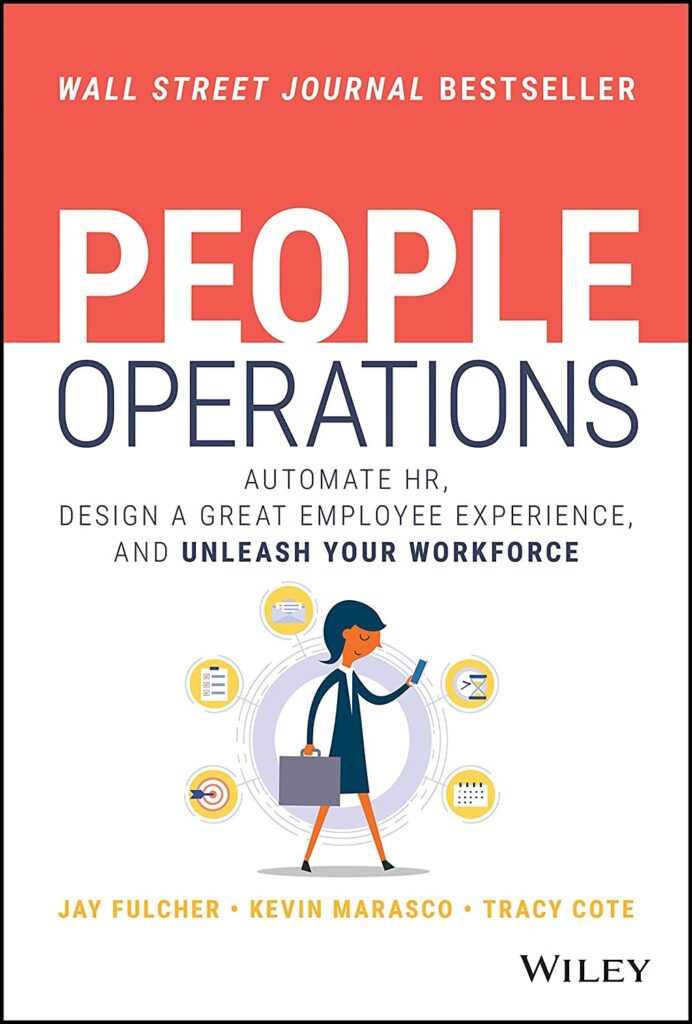Hey there, Jim Van Wyck here with another book review for HealthyHalo.com.
I just finished People Operations by Jay Fulcher, Tracy Cote, and Kevin Marasco, and let me tell you, this book is a game-changer for anyone interested in how to manage a team in today’s fast-paced, tech-driven world.

People Operations redefines the traditional HR model and focuses on employee experience, data analytics, and automation. The authors argue that modern companies need to ditch the old-school HR methods and embrace a more strategic, people-centered approach.
The goal?
Not just keeping employees happy, but actively driving business growth through smarter workforce management.
The authors present clear strategies on how to use tech to streamline hiring, onboarding, and employee development. You know, the kind of practical steps you can start using today. And what’s cool is they back it all up with real-world examples from companies that are already thriving with this new method.
If you’re in any kind of leadership or HR role—or even just someone curious about the future of work—this is a book you don’t want to miss.
It’s packed with insights you can take straight to the office and apply immediately.
Chapter By Chapter Summary
Introduction: The Evolution of HR into People Operations
The introduction sets the foundation for the entire book by positioning traditional HR as a relic of the past.
The authors argue that today’s businesses are facing unprecedented challenges due to technological advancements, remote work, and changing workforce expectations. HR needs to evolve to keep up.
They introduce the concept of “People Operations,” which they define as a more strategic, data-driven, and employee-focused approach to managing people. The goal is not just to manage employees but to maximize their potential in a way that also drives business results.
In this introduction, you’ll find the key themes that run through the rest of the book: automation, employee experience, and data analytics.
The authors make it clear that People Operations isn’t just a rebranding of HR but a fundamental shift in how companies operate. You’ll also get a sense of the urgency behind this shift—those who fail to adapt risk being left behind in a rapidly changing marketplace.
The introduction sets the stage for the book’s detailed exploration of how to transform a traditional HR department into a People Operations powerhouse.
Chapter 1: The New World of Work
This chapter dives into the major trends reshaping the workforce today.
Flexible work arrangements, remote work, and the rise of the gig economy have fundamentally changed the way people approach their careers. The authors argue that these trends aren’t just temporary but are the new reality. As such, companies need to adapt their approaches to hiring, onboarding, and managing employees.
A key takeaway here is the importance of offering flexibility to employees. Companies that embrace flexible work environments—whether through remote work options, flexible hours, or freelance work—are more likely to attract top talent.
Additionally, employees today are looking for more than just a paycheck; they want purpose and fulfillment in their work. You’ll also learn about the growing importance of continuous learning and development, as employees expect opportunities for growth and upskilling.
The chapter is filled with data and examples that highlight how forward-thinking companies are successfully navigating these changes. You’ll come away with a clear understanding of why the “new world of work” requires a fundamentally different approach to managing people.
Chapter 2: The Shift from HR to People Operations
In this chapter, the authors lay out the core principles of People Operations and how it differs from traditional HR.
HR is often seen as a reactive function—managing payroll, handling benefits, and dealing with compliance issues.
People Operations, on the other hand, is proactive and strategic. It focuses on using data and technology to streamline these administrative tasks so that HR professionals can focus on higher-value activities like employee development and culture-building.
You’ll learn how automation plays a critical role in this shift.
By automating routine tasks, companies can free up their HR teams to focus on people rather than paperwork. The authors also emphasize the importance of using data to make better decisions. For example, rather than relying on intuition or gut feelings,
People Operations uses data to optimize recruitment, improve employee engagement, and even predict turnover.
The chapter also includes case studies from companies that have successfully made the shift from traditional HR to People Operations.
These examples serve as practical illustrations of how the transition can work in real life, making it clear that this isn’t just a theoretical concept but something that companies can implement today.
Chapter 3: Employee Experience as a Core Business Function
This chapter focuses on the importance of employee experience (EX) and why it should be treated as a core business function, not just an HR concern.
The authors argue that companies often invest heavily in customer experience (CX) but neglect the experience of their employees. Yet, in today’s competitive market, companies that prioritize employee experience see significant benefits, including higher retention rates, better employee engagement, and improved performance.
The authors break down the employee journey into several key stages: recruitment, onboarding, development, retention, and offboarding.
For each stage, they offer practical advice on how to improve the employee experience. For example, during recruitment, companies can use technology to create a seamless application process. During onboarding, a focus on culture and connection can make new employees feel more engaged from day one.
A major theme in this chapter is the use of technology to enhance employee experience.
The authors discuss how tools like employee portals, digital feedback systems, and real-time analytics can help companies create a more personalized and satisfying work environment. By the end of the chapter, you’ll have a clear roadmap for treating employee experience as a business imperative, not just a nice-to-have.
Chapter 4: Building People-Centric Cultures
Culture is the backbone of any successful organization, and this chapter delves deep into how to create and maintain a people-centric culture.
The authors argue that culture is not just about perks like free snacks or casual Fridays. It’s about creating an environment where employees feel valued, empowered, and aligned with the company’s mission and values.
The authors emphasize that culture starts at the top.
Leadership must set the tone, but everyone in the organization plays a role in shaping the culture. They discuss the importance of creating a culture that fosters inclusion, transparency, and continuous learning. You’ll read about companies that have succeeded in building strong cultures, with practical examples of how they did it.
One of the key takeaways from this chapter is the idea that culture is not static—it evolves as the company grows and changes. The authors encourage companies to regularly assess their culture and make adjustments as needed.
They also discuss the role of technology in building culture, such as using collaboration tools to foster communication and connection in a remote or distributed workforce.
Chapter 5: Technology and Automation in People Operations
Technology is the driving force behind many of the changes in People Operations, and this chapter provides a detailed exploration of how companies can leverage it to improve their HR functions. The authors focus on the role of automation in streamlining routine tasks like payroll, benefits administration, and compliance tracking.
By automating these processes, HR teams can focus on more strategic initiatives, such as employee development and company culture.
The authors also discuss the rise of artificial intelligence (AI) in People Operations. For example, AI can be used to analyze job applicants, predict which employees are likely to leave, and even provide personalized recommendations for employee development.
The chapter explains that while technology can’t replace the human element of HR, it can augment it by providing data-driven insights that help HR professionals make better decisions.
You’ll also learn about the importance of integrating various HR technologies into a single platform. Many companies struggle with managing multiple systems for payroll, recruitment, and employee engagement. The authors suggest that an integrated system can improve efficiency and provide a more holistic view of the employee experience.
Chapter 6: The Power of People Data
Data is the new currency in People Operations, and this chapter is all about how to harness it effectively.
The authors argue that data-driven decisions lead to better outcomes, both for employees and for the business. They explore the various types of data that companies can collect, including employee engagement surveys, performance metrics, and even social media activity.
One of the key points in this chapter is that data isn’t just for HR—it should be shared across the organization. For example, managers can use data to identify high-potential employees and provide targeted development opportunities. Executives can use data to understand trends in employee satisfaction and make strategic decisions that align with business goals.
The chapter also covers the ethical considerations of using employee data. The authors emphasize the importance of transparency and ensuring that employees understand how their data will be used.
They suggest that companies should create clear policies around data collection and use, to build trust with employees.
Chapter 7: Designing Employee Development Programs
Employee development is critical for keeping your workforce engaged and prepared for the future, and this chapter provides a comprehensive guide to creating effective development programs.
The authors argue that one-size-fits-all development programs are no longer sufficient. Instead, companies should focus on personalized development plans that take into account each employee’s strengths, weaknesses, and career aspirations.
The chapter explores different types of development programs, from formal training sessions to mentorship and coaching.
You’ll learn how to create programs that are both scalable and tailored to individual needs. The authors also emphasize the importance of upskilling and reskilling in today’s rapidly changing work environment, where the skills that are in demand today may not be relevant in a few years.
Another key takeaway from this chapter is the role of technology in employee development. The authors discuss how learning management systems (LMS) and digital learning platforms can make it easier to provide continuous learning opportunities.
By the end of the chapter, you’ll have a clear framework for designing employee development programs that not only meet the needs of your workforce but also align with your company’s strategic goals.
Chapter 8: Managing Change and Driving Innovation
Change is inevitable in any organization, and this chapter explores how People Operations can help companies navigate it smoothly. The authors argue that managing change is one of the most important functions of People Operations, especially in today’s fast-paced business environment.
Whether it’s a company restructuring, a shift to remote work, or the implementation of new technology, change management requires careful planning and execution.
The chapter provides practical strategies for managing organizational change, including how to communicate effectively with employees and how to create a sense of urgency without causing panic. The authors also emphasize the importance of involving employees in the change process, to increase buy-in and reduce resistance.
Innovation is another key theme in this chapter. The authors argue that companies with strong People Operations are better positioned to drive innovation, as they have the systems in place to support experimentation and risk-taking.
You’ll learn how to create a culture of innovation where employees feel empowered to bring new ideas to the table and experiment without fear of failure.
Chapter 9: The Future of People Operations
The final chapter looks ahead to the future of People Operations, offering a forward-looking perspective on how the field will continue to evolve. The authors predict that as technology continues to advance, People Operations will become even more central to business strategy. Remote work, diversity and inclusion
Here’s a 2-column table summarizing the key concepts and actionable insights from People Operations:
| Concept | Key Insights / Actionable Takeaways |
|---|---|
| The Shift from HR to People Operations | Traditional HR is reactive; People Operations is proactive and strategic. Use automation and data to optimize processes and focus on higher-value tasks like culture and development. |
| Employee Experience as Core Business Function | Treat employees like internal customers. Improve recruitment, onboarding, and employee journeys to boost engagement and retention. Prioritize seamless, positive experiences. |
| Technology and Automation | Automate routine tasks (e.g., payroll, compliance) to free HR professionals for strategic roles. Leverage AI and analytics for smarter, data-driven decisions about talent management. |
| Data-Driven Decision Making | Use employee data to predict turnover, identify skills gaps, and enhance engagement. Sharing insights across teams helps align employee performance with business goals. |
| Building People-Centric Cultures | Culture must be intentionally designed and nurtured. Focus on inclusion, transparency, and continuous learning. Leadership sets the tone, but every employee shapes the culture. |
| Personalized Employee Development | Move away from generic development programs. Create individualized growth plans for employees that align with both their personal goals and company objectives. |
| Managing Change and Driving Innovation | Foster open communication during organizational changes. Create a culture of experimentation, where employees are encouraged to innovate and take risks without fear of failure. |
| The Future of Work | Embrace flexibility (remote work, gig economy) and invest in diversity, inclusion, and mental health. People Operations will continue to grow in importance as the workforce evolves. |
This table offers a quick reference to the major concepts discussed in the book and the corresponding actions or strategies you can implement.
Applications For Bus and Motorcoach Companies
For motorcoach and bus companies facing driver shortages and high turnover, the concepts from People Operations offer practical solutions that can be adapted to address these challenges.
Here’s a summary of how these principles can be applied:
- Reimagine Recruitment and Onboarding: Motorcoach companies can enhance their recruitment efforts by focusing on a more seamless and positive experience for potential drivers. This means automating parts of the recruitment process to reduce friction and adopting data-driven methods to identify the most suitable candidates. A strong, personalized onboarding process can also help new drivers feel valued and integrated from day one, reducing early turnover.
- Focus on Employee Experience (EX): Treat drivers like internal customers by creating an employee experience that promotes loyalty. This involves providing flexible work schedules, showing appreciation, and ensuring a supportive work environment. Investing in driver wellness—such as mental health support or wellness programs—can boost satisfaction and retention, reducing turnover.
- Leverage Technology and Automation: Automating administrative tasks like scheduling, payroll, and benefits can reduce frustrations for drivers and HR teams alike. By freeing up time for higher-value tasks, HR teams can focus on improving the driver experience and addressing specific issues that lead to turnover, like long hours or lack of flexibility.
- Build a People-Centric Culture: Cultivate a company culture that prioritizes drivers’ needs and well-being. Make sure drivers feel part of a team and aligned with the company’s mission. Open communication channels between management and drivers can foster trust and make drivers feel heard, leading to greater retention.
- Offer Development and Growth Opportunities: Continuous learning and development can be a key differentiator in retaining drivers. Offering training programs or career advancement opportunities (e.g., leadership roles or certifications) shows drivers that the company is invested in their long-term growth.
- Use Data to Predict and Solve Turnover: Leverage data analytics to identify trends in driver turnover and predict when drivers may leave. This proactive approach allows companies to address issues before they escalate, such as identifying overworked drivers or recognizing burnout signs early.
- Manage Change Effectively: As the industry evolves, clear communication and driver involvement in decision-making can help reduce resistance to changes, whether it’s new technology or shifts in company policies.
By adopting these People Operations strategies, motorcoach and bus companies can address driver shortages, reduce turnover, and build a more engaged, loyal workforce.
Get A Copy
If you’re ready to transform how your business approaches managing people—and tackle challenges like turnover and employee engagement—People Operations is a must-read. I’ve seen firsthand how its strategies can apply to industries like motorcoach and bus companies, and I know it can make a difference for you too.
Head over to Amazon now and grab your copy.
Trust me, this book has the insights you need to turn workforce challenges into opportunities for growth.


